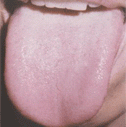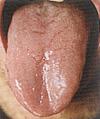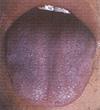This part includes observation of the overall body (spirit, color, form, bearing) as well as localized areas of the body, and the tongue etc. This is a method for TCM physicians to understand and predict the pathological changes of internal organs through observing abnormal changes in the patient's vitality, appearance, behavior, secretions and excretions. The Chinese physicians realized a close relationship between the external body, especially the face and tongue, and the internal
organ systems, a slight change appearing on the body surface can reveal the pathological condition of particular region of internal body. Chinese medicine inspection usually focuses on the followings:
Check spirit
Spirit is the outward manifestation of vital activities, and is checked through the eyes, expressions, body motions, speech, and responses of patients. By inspecting it, one gains insight into the development of the disease, and can measure the strength or weakness of the disease, and judge the prognosis. If the person behaves normally, is alert and co-operative, the disease is usually mild; but if responses are sluggish or confused, the disease could be serious.
Check color
Skin color varies according to your race; the appearing of skin reflects the prosperity or decline of
qi (vital energy) and
essence. According to the
five elements theory, there are five colors that correspond to organs - green is for the
liver, red for the
heart, yellow for the
spleen, white for the
lungs, and black for the
kidneys. Changes in skin complexion reflect the nature of a disease and involved organs. Discolorations are usually seen in: purple or green-blue, yellow, red, pale and dark gray.
Common discolorations in TCM examination
| Discoloration |
Associated disharmonies |
| Purple, green-blue |
Disharmony of cold, painful conditions, blood stasis or liver disease |
| Flush red |
Heat disharmony |
| Sallow |
Dampness disharmony, deficient disharmony |
| Pale |
Cold disharmony, blood deficiency |
| Dark gray |
Kidney deficiency, cold disharmony, painful condition, blood stasis or body fluid problem |
Check form
Physicians look at the body shape and any deformity on the body. A normal form appears as well-developed physique, firm and straight skeleton, strong muscles, free of motions and quick response. TCM believes overweight people tend to accumulate
phlegm or
dampness in the body; a thin person with dry skin indicates insufficiency of blood; great loss of weight in chronic illness indicates exhaustion of essence.
Check bearing
The patient's body movement and posture can help evaluate pathological changes. For example, paralysis on one side of body, facial distortion, limb cramps, and twitching of lips or cheek may indicate stroke; when hypertensive individuals experience finger numbness, head heaviness and lightness in lower limbs, it may indicate the aura of stroke; limb contraction, restricted movements, swelling and painful joints appear in rheumatoid arthritis.
TCM Tongue Study

Division of tongue surface Observation of the tongue, also known as tongue diagnosis, is an important procedure in TCM examination. It includes observing the tongue's form and color, and any coating it may have. The tongue body refers to the muscular tissue of the tongue. The tongue coating (fur) refers to a layer of "moss" over the tongue surface, which is produced by the stomach qi. In ancient times, it was established that different parts of the tongue correspond to different internal organs. The tip of the tongue reflects the heart and lungs; the middle part, the spleen and
stomach; its root, the kidneys; and both sides of the tongue, liver and
gall-bladder. The tongue body and fur together create the tongue sign. Tongue signs are an important factor in diagnosis, as changes in the signs, reflect changes in the condition of the disease. A normal tongue sign is proper size, soft in quality, free in motion, pale red in color and with a thin layer of white coating which is neither dry nor overly moist.
 |
 |
 |
| Pale tongue with white and thin coating |
Pale red tongue with white glossy coating |
Red tongue with fissures; and the coating is white, thin and a little rough |
 |
 |
 |
| Red tongue with yellow, thick and greasy coating |
Deep red tongue without any coating |
Purple tongue with white, thin and slimy coating |
Commonly tongue signs during clinical examination are below:
| Tongue body |
Tongue coating |
Problem Indicated |
| Pale, tender, slightly larger than normal |
Thin, white |
Qi deficiency |
| Pale, normal in size or slightly shrunken |
Slightly dry, thin, white |
Blood deficiency |
| Pale, enlarged and tender, teeth marks on the sides |
Moist with much fluid, white and thick |
Deficiency of yang qi leading to accumulation of cold and dampness internally |
| Pale |
Thin, white, peeled center |
Insufficient stomach yin |
| Pale |
Yellow, slimy |
Weakness of spleen and stomach |
| Pale red |
Thin, white, moist |
Normal, or contraction of wind and cold evils. |
| Pale red with a red tip |
White fur |
Heart fire blazing |
| Red |
Yellow and rough |
Retention of heat |
| Red, prickles |
Thick, yellow, dry |
Extreme heat in the interior |
| Red |
Dry in center of the tongue |
Heat scorching the stomach fluids |
| Red |
Yellow and slimy |
Dampness and heat disturb qi movements |
| Red |
Thick, yellow and glossy |
Dampness and heat distending and stagnating in spleen and stomach |
| Red |
Little or no fur |
yin deficiency with internal heat |
| Deep red (crimson), prickles |
Thick and yellow |
Heat evil entering the blood |
| Deep red |
Dry and cracked fur |
Excess heat exhausting yin |
| Deep red |
Black |
Extreme heat disharmony |
| Deep red, shrunken |
Dry, little or no fur |
Long term yin deficiency |
| Deep red |
Yellow and slimy |
Internal heat accompanied phlegm and dampness accumulation |
| Dark red |
Purplish spots or patch |
Blood stasis plus heat |
| Pale purple, tender |
Glossy and moist |
Internal cold flourishing |
| Blue green or purple |
White and glossy |
Blood stasis |
| Blue green or purple |
Yellow and dry |
Exhaustion of yin and blood, or yin deficiency with excess virtual fire |
| Blue green |
White and glossy |
Extreme cold disharmony |
 Division of tongue surface Observation of the tongue, also known as tongue diagnosis, is an important procedure in TCM examination. It includes observing the tongue's form and color, and any coating it may have. The tongue body refers to the muscular tissue of the tongue. The tongue coating (fur) refers to a layer of "moss" over the tongue surface, which is produced by the stomach qi. In ancient times, it was established that different parts of the tongue correspond to different internal organs. The tip of the tongue reflects the heart and lungs; the middle part, the spleen and stomach; its root, the kidneys; and both sides of the tongue, liver and gall-bladder. The tongue body and fur together create the tongue sign. Tongue signs are an important factor in diagnosis, as changes in the signs, reflect changes in the condition of the disease. A normal tongue sign is proper size, soft in quality, free in motion, pale red in color and with a thin layer of white coating which is neither dry nor overly moist.
Division of tongue surface Observation of the tongue, also known as tongue diagnosis, is an important procedure in TCM examination. It includes observing the tongue's form and color, and any coating it may have. The tongue body refers to the muscular tissue of the tongue. The tongue coating (fur) refers to a layer of "moss" over the tongue surface, which is produced by the stomach qi. In ancient times, it was established that different parts of the tongue correspond to different internal organs. The tip of the tongue reflects the heart and lungs; the middle part, the spleen and stomach; its root, the kidneys; and both sides of the tongue, liver and gall-bladder. The tongue body and fur together create the tongue sign. Tongue signs are an important factor in diagnosis, as changes in the signs, reflect changes in the condition of the disease. A normal tongue sign is proper size, soft in quality, free in motion, pale red in color and with a thin layer of white coating which is neither dry nor overly moist.







